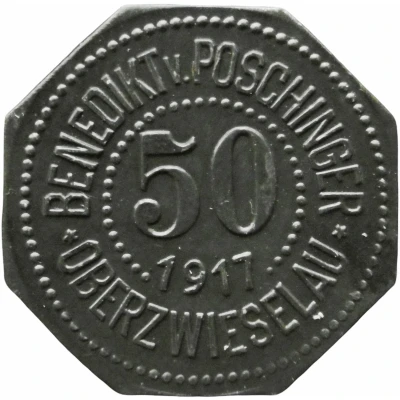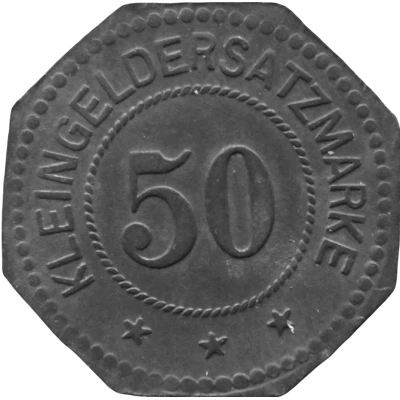


© Willem63 (CC BY-NC-SA)
50 Pfennigs - Oberzwieselau Benedikt v. Poschinger
1917 year| Zinc | 2.9 g | 24.3 mm |
| Issuer | Municipality of Oberzwieselau (Federal state of Bavaria) |
|---|---|
| Emperor | William II (Wilhelm II) (1888-1918) |
| Type | Standard circulation coin |
| Year | 1917 |
| Value | 50 Pfennigs (50 Pfennige) (0.50) |
| Currency | Mark (1914-1924) |
| Composition | Zinc |
| Weight | 2.9 g |
| Diameter | 24.3 mm |
| Thickness | 1.0 mm |
| Shape | Octagonal (8-sided) |
| Technique | Milled |
| Orientation | Medal alignment ↑↑ |
| Demonetized | Yes |
| Updated | 2024-10-04 |
| Numista | N#289926 |
|---|---|
| Rarity index | 97% |
Reverse
Pearl rim, legend surrounding beaded circle with denomination centered
Script: Latin
Lettering:
KLEINGELDERSATZMARKE
50
★ ★ ★
Edge
Plain
Comment
Menzel: BBBFa: Glasfabrik
Interesting fact
One interesting fact about the 50 Pfennigs - Oberzwieselau (Benedikt v. Poschinger) 1917 coin is that it was issued during a time of economic turmoil in Germany. The country was facing hyperinflation, and the value of the German mark was rapidly decreasing. In response, the government introduced a new currency, the Rentenmark, which was pegged to gold and was intended to stabilize the economy. The 50 Pfennigs coin was part of this new currency system and was used widely in circulation during this time. Despite the economic challenges, the coin remains a valuable collector's item today, with some mint conditions selling for hundreds of euros.